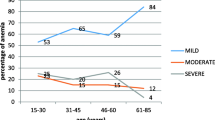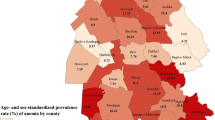Abstract
Anemia, defined by low hemoglobin level, is recognized as a major public health problem that has a significant impact on lifelong health. In 2014, the Kuwait Nutrition Surveillance System stated that the prevalence of anemia was 9.7% in adult males and 32.7% in adult females. This study aimed to establish the prevalence and classification of anemia among adult patients attending the Capital Governorate hospital of Kuwait. It is a retrospective record-based study. The study included patients (aged 18–60 years) attending Amiri Hospital OPD and primary care centers affiliated from January 2014 to December 2018. Hemoglobin levels were taken from the Laboratory Information System (LIS) and were classified as mild, moderate, and severe based on WHO classification. This study showed that anemia was more prevalent among the Kuwaiti population than non-Kuwaitis. The maximum percentage of anemic people belonged to the moderate and mild range of anemia; a very low percentage was found in the severe range. The incidence of anemia was significantly higher among females compared to males (16–17% of females and 4–5% of males in the moderate range; 16–18% of females and 10–11% of males in the mild range; 2–3.3% of females and 0.8–1.1% of males in the severe range). Age-wise comparison of data showed that anemia was more common among the older age groups. Prevalence of anemia is quite high in Kuwait; therefore, more studies and interventions are needed for certain vulnerable groups—specifically for women and people from older age groups—to reduce the risk of anemia.



Similar content being viewed by others
References
WHO. Nutritional anemia: report of a WHO scientific group. Geneva: WHO, 1968.
McLean E, Cogswell M, Egli I. Worldwide prevalence of anemia, WHO vitamin and mineral nutrition information system. Public Health Nutr. 200;12:444–454.
Benoist BD, McLean E, Egli I. WHO global database on anemia. Geneva: World Health Organization, 2008.
Durrani A. Prevalence of anemia in adolescents: a challenge to the global health. ACTA Sci Nutr Health. 2018;2:24–7.
Kassebaum N, Jasrasaria R, Naghavi M, Wulf SK, Johns N, Lozano R, et al. A systemic analysis of global anemia burden from 1990 to 2010. Blood. 2014;123:615–24.
WHO. Haemoglobin concentrations for the diagnosis of anaemia and assessment of severity. Retrieved: July 15, 2019, from World Health Organization.
Al-Qaoud NM, Al Shami E, Prakash P. Anemia and associated factors among Kuwaiti preschool children and their mothers. Alexandria J Med. 2015;51:161–6.
Diejomaoh FM, Haider MZ, Dalal H, Abdulaziz A, D'Souza TM, Adekile AD. Influence of alpha-thalassemia trait on the prevalence and severity of anemia in pregnancy among women in Kuwait. Acta Haematol. 2000;104:92–4.
Adekile A, Haider M. Haptoglobin gene polymorphisms in sickle cell disease patients with different betaS-globin gene haplotype. Med Princ Pract. 2010;19:447–50.
Kuwait Nutrition Surveillance System 2014 Annual Report. Retrieved 07 18, 2019, from Kuwait Ministry of Health: https://www.moh.gov.kw/Renderers/ShowPdf.ashx?Id=aa1caabd-6aea-4dbb-9441-c9768458941d.
Maakaron JE, Besa EC. Sickle cell anemia. Medscape Reference [software]. 2013. https://emedicine.medscape.com/article/198475-overview#a6.
AlMousaa Z, Prakasha P, Jackson RT, AlRaquaa M. A comparison of selected nutrient intakes in anemic and nonanemic adolescent girls in Kuwait. Nutr Res. 2003;23:425–33.
Al Zenki S, Alomirah H, Al Hooti S, Al Hamad N, Jackson RT, Rao A, et al. Prevalence and determinants of anemia and iron deficiency in Kuwait. Int J Environ Res Public Health. 2015;12:9036–45.
Le CH. The prevalence of anemia and moderate-severe anemia in the US population (NHANES 2003-2012). PLoS One. 2016;11:e0166635.
Mahoney DH Jr. Anemia in at-risk populations—what should be our focus? Am J Clin Nutr. 2008;88:1457–8.
WHO C. Worldwide prevalence of anaemia 1993–2005. WHO global database on anaemia 2008. https://www.who.int/vmnis/database/anaemia/anaemia_status_summary/en/.
Author information
Authors and Affiliations
Corresponding author
Ethics declarations
Conflict of Interest
The authors declare that they have no conflict of interest.
Ethical Approval
Ethical approval of this study was granted by the Ethics Committee of Kuwait Ministry of Health.
Informed Consent
Not applicable.
Additional information
Publisher’s Note
Springer Nature remains neutral with regard to jurisdictional claims in published maps and institutional affiliations.
This article is part of the Topical Collection on Medicine
Rights and permissions
About this article
Cite this article
AlDallal, S.M., Al-Hilal, M. Prevalence of Anemia Among Adults at Capital Governorate in Kuwait. SN Compr. Clin. Med. 2, 164–172 (2020). https://doi.org/10.1007/s42399-019-00205-y
Accepted:
Published:
Issue Date:
DOI: https://doi.org/10.1007/s42399-019-00205-y




